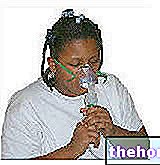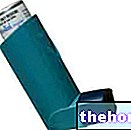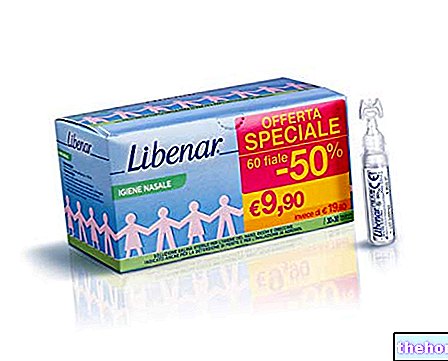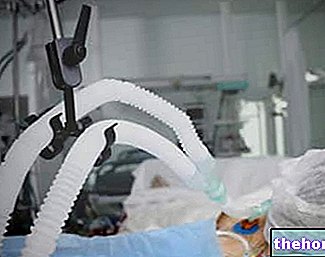Watch the video
- Watch the video on youtube
Aerosol therapy requires a device that reduces therapeutic substances into microscopic corpuscles, which are able to reach the mucous membranes of the nose, larynx, trachea, bronchi and lungs with greater ease.

The inhaled administration of a drug, by means of aerosol therapy, allows a "high therapeutic efficacy, especially if we consider:
- The ratio of the necessary therapeutic doses;
- The ability to selectively treat the upper, middle or lower airways. For example, only particles with an aerodynamic diameter of less than 5 microns are able to reach bronchioles and alveoli, in significant quantities to exert their activity.
The advantages of this route of administration are:
- Maximum local effect and rapid therapeutic action: the topical bioavailability of the drug is significantly increased and systemic diffusion is extremely decreased;
- The drug is delivered directly to the target to be treated;
- Reduced dosages of the drug are required to achieve the therapeutic effect;
- Minimum incidence of any side effects, much lower than those caused by systemic administration. Several pharmacological substances taken by inhalation have a poor systemic bioavailability, since they are inactivated by pulmonary enzymes (beta 2-agonists) or inactivated at the first hepatic pass (corticosteroids);
- Easy home use, even for children and the elderly.
Aerosol for adults and children

This compact and handy piston aerosol allows a quality nebulization with any type of medicine or oily solution.
Specifically, piston aerosols are able to generate droplets with a smaller diameter than ultrasonic nebulizers. The more "the fog" generated is made up of small droplets, the easier it will be to reach the lower respiratory tract.
If the attending physician has prescribed a therapy based on cortisone or oily substances, the piston technology allows correct nebulization without any molecular alteration of the drug.
The device is shipped together with an adult and child mask, a nose fork, a mouthpiece, a washable ampoule and 2 filters

This portable piston inhaler can be used to treat bronchitis, sinusitis, allergies and colds.
Ultra-quiet and low-power consumption, the device is equipped with a high-performance lithium battery that can be easily recharged via the supplied Micro-USB charger.
Very convenient to carry thanks to its light weight and compact size, this aerosol guarantees high atomization and nebulization efficiency, which makes the absorption of drugs more effective.
it is conditioned by different parameters, which depend on the same drug or on the patient's anatomical, physiological and pathological characteristics.
- Nature of the drug: chemical structure, solubility, hygroscopy;
- Pharmaceutical preparation (aerosol characteristics):
- Characteristics of the atomized particles: size, density, speed, electric charge;
- Formulation (for example: fat-soluble compounds such as cortisone and dexamethasone, are absorbed more quickly);
- Drug deposition site and elimination mechanism;
- Delivery device: nebulization rate, pressure and delivery conditions.
- Characteristics of the patient: sex, age, morphology of the respiratory tree, patency of the airways and present pathologies.
- Characteristics of inhalation: inspired volume, speed of inspiratory flows, respiratory rate, apnea time.
Aerosol therapy allows you to:
- Humidify the airways;
- Administer locally the drugs vaporized in physiological solution;
- Reduce bronchospasms affecting the bronchial lumen and edema of the respiratory mucous membranes;
- Make the tracheo-bronchial secretions more liquid, in order to facilitate their elimination.
The most commonly used therapeutic substances by aerosol are:
- Mucolytics;
- Cortisones;
- Antibiotics;
- Anti-inflammatories;
- Preventive antiallergics;
- Anti-asthmatics;
- Bronchodilators.
The aerosol is generally used in the therapy of many respiratory diseases, for which the most effective way of administering drugs is the inhalation route: rhinitis, sinusitis, tonsillitis, colds, bronchitis, pneumonia, bronchopneumonia, tracheitis, whooping cough, pneumonia, pharyngitis, etc. .
Other indications for the use of aerosol therapy include the management of exacerbations and long-term treatment of chronic obstructive pulmonary disease (COPD), therapeutic control of cystic fibrosis, and seeking symptomatic relief in palliative care. Limited use of nebulizers may also be indicated for the management of bronchial asthma.
The efficacy of the therapy is greater orally, while the nasal one retains a large part of the solution, which thus fails to reach the lower respiratory tract, such as the small bronchi. In general, particles with a diameter greater than 8 microns impact at level of the oropharynx, while the particles of an aerosol capable of depositing at the level of the lower airways have dimensions between 0.5 and 5 microns. Furthermore, only 10-15% of the drug delivered tends to be absorbed by the lungs: for this reason it is important to use the nebulizer correctly.
In addition to the nebulizer and the ampoule, the device also includes a series of different accessories, to be chosen according to need:
- The mouthpiece: it must be held between the teeth, with the mouth closed and the nose closed with the fingers or a clip. If the patient's age and ability to cooperate allow, the mouthpiece is the preferred dispenser for lower airway inhalation therapy. Compared to the mask, in fact, it prevents the nasal deposition of the drug from occurring (remember that the nose acts as a filter, limiting the therapeutic effect of the therapeutic substance).
- The mask: must be used in cases where the use of the mouthpiece
it is not easy to apply, as in the case of pediatric application. The mask must adhere well to the face, so as not to disperse the solution outside; must cover mouth and nose together. It is the most convenient device to use, however it can also deposit the aerosol on the skin of the face, eyes and nasal mucosa, which can filter the therapeutic substance before it reaches the target area of the treatment.
- The nasal fork: is used in case of direct administration to the mucous membrane of the nose; finds little real application (for example, for certain conditions, we tend to prefer the nasal douche).

There are two main types of nebulizers for aerosol therapy:
- Pneumatic nebulizer:
- it uses a jet of air generated by a compressor to produce homogeneous and stable particles;
- it is equipped with an ampoule that guarantees a good quality nebulization;
- cheap and very resistant, but quite noisy (a factor that can be disturbing for a pediatric patient).
- Ultrasonic Nebulizer:
- they exploit the vibration of quartz crystals;
- they are expensive, but less noisy than pneumatic ones;
- they are faster in the atomization time and guarantee an excellent vaporization;
- they can modify the structure of some drugs by inactivating them, due to the way in which the suspension is subjected to fragmentation.
The nebulizer is a simple to use device for aerosol therapy, but it is rather bulky. Other technologies, which allow the administration of medicinal substances by inhalation, are compact and portable:
- Metered Dose Inhaler (MDI): they are
mainly used for the treatment of asthma and chronic obstructive pulmonary diseases (COPD), as they allow for practical self-medication, with accurate and reproducible doses of the drug (usually, a corticosteroid or a bronchodilator). For the use of this device, an excellent coordination between aerosol delivery and inspiratory act is required.
- Dry Powder Inhaler (DPI): The medicine is not in liquid form, but is made up of a dry powder.
While using the device
- Assemble the connection tubes, ampoule and mouthpiece (or mask) of the nebulizer;
- Put the prepared solution (usually physiological solution + drug) in the nebulizer ampoule;
- Sit with the trunk erect, in a relaxed position;
- Operate the device;
- Nebulize the drug under vacuum for at least 15 seconds, to saturate the walls of the ampoule and stabilize the suspended particles;
- Keep the nebulizer upright during administration;
- The way you breathe has a great influence on the amount of aerosol that reaches the airways. In order to promote maximum deposition of particles, it is necessary to inhale slowly, trying to hold the breath for 5-10 seconds, before exhaling.
- The delivery time for 2-3 ml of drug is approximately 8-10 minutes: breathe until the nebulizer produces no crackling or no aerosol is produced.
Cleaning
- Rinse the nebulizer with water (preferably distilled) and dry in the air, daily in case of regular use and after each use in case of occasional use.
- The mask, mouthpiece and ampoule must be disconnected, disassembled and washed in hot water, without using detergents. The components must be left to air dry overnight.
Maintenance
- Disposable components, such as the mouthpiece, mask, connecting tube and ampoule should be replaced every 3-4 months for continuous use.
Practical matters
When purchasing the nebulizer, the patient should be provided with some essential information by health professionals (doctors, nurses and pharmacists), including:
- Instructions for use, cleaning and maintenance of the appliance and accessories;
- Ability of the device to nebulize the various drugs without undergoing molecular alterations.
- Nebulization time (ml / min).

























-nelle-carni-di-maiale.jpg)




